- 1. Ferment feed
- 2. Don’t let ducks overeat
- 3. Reduce feed wastage
- 4. Change feeds
- 5. Choice feeding
- 6. Sprout grains
- 7. Free range
- 8. Rotate pasture
- 9. Hang light at night
- 10. Feed leftovers/kitchen waste
- 11. Keep light breeds
- 12. Let your ducks into the garden
- 13. Grow a ducky garden
- 14. Seed yard/pasture with nutritious grasses and weeds
- 15. Grow soldier fly grubs, mealworms, or earthworms
- What if I unbalance their diet?
- One last tip
Duck feed is expensive, certainly the largest expense associated with raising ducks.
Naturally, you probably want to find ways to save money on feed. Maybe you also want to reduce your reliance on outside sources. Here, I’m going to share 15 methods for reducing feed costs. Some are easy and free; others require some land, time, or investment. No matter your circumstances, I’m sure you’ll find at least three or four ideas to try.
And if you’re able to apply all of these tips, you may even be able to feed your ducks for free or completely eliminate purchased feed. How awesome would that be?
Disclosure: This post contains affiliate links. As an Amazon Associate, I earn a commission if you purchase something through a link on this post, at no additional cost to you.
1. Ferment feed
Fermenting feed is popular among backyard poultry raisers, and for good reason. It’s easy, it’s free, it doesn’t take much time, absolutely anyone can do it, and it reduces feed costs. I have been fermenting my birds’ feed for about four years and I highly recommend it.
Lacto-fermentation of poultry feed has many advantages, such as producing beneficial gut bacteria, reducing antinutrients (phytic acid, in particular), increasing the bioavailability of vitamins and minerals, and creating new nutrients (such as enzymes, vitamin K, folic acid, riboflavin, niacin, thiamine, and even the essential amino acid lysine, which most grains are very low in).
Overall, it enables your ducks to obtain more nutrition out of the same amount of feed, so they will eat less. Many sources say you should be able to reduce their feed consumption by 15-20%, and perhaps more. I think this is an exaggeration, but not a lie. A more realistic number might be 5-10%.
To ferment your ducks’ feed, all you have to do is soak it for about 3-4 days and then feed it to your ducks. It really is that easy.
For more details (what to put the feed in, how much water to use, what can go wrong, etc.), check out this awesome guide to fermenting feed:
Here’s another guide:
2. Don’t let ducks overeat
If given the opportunity, ducks will usually eat more than they need. They may also snack from the feeder when they could have been foraging instead.
Don’t let your adult ducks have constant access to feed if you want to reduce feed costs. As long as they have the ability to forage, it’s not necessary.
To optimize feed consumption, feed your ducks twice a day however much they can clean up within 15-30 minutes. This should ensure they are getting enough food, but not more than they need.
Feeding once a day is also an option, but you’ll need to leave enough feed that they can eat it over a period of several hours.
When foraging is limited, I recommend allowing ducks to eat for longer, or at least feeding them three times a day.
If you have Pekins or another heavy breed, limiting feeding is especially important. Most ducks won’t overeat enough to get fat or cause health problems, but Pekins often will. They need to be on a limited diet.
If you have ducklings, disregard this advice. Ducklings need food 24/7 for at least their first two weeks.
3. Reduce feed wastage
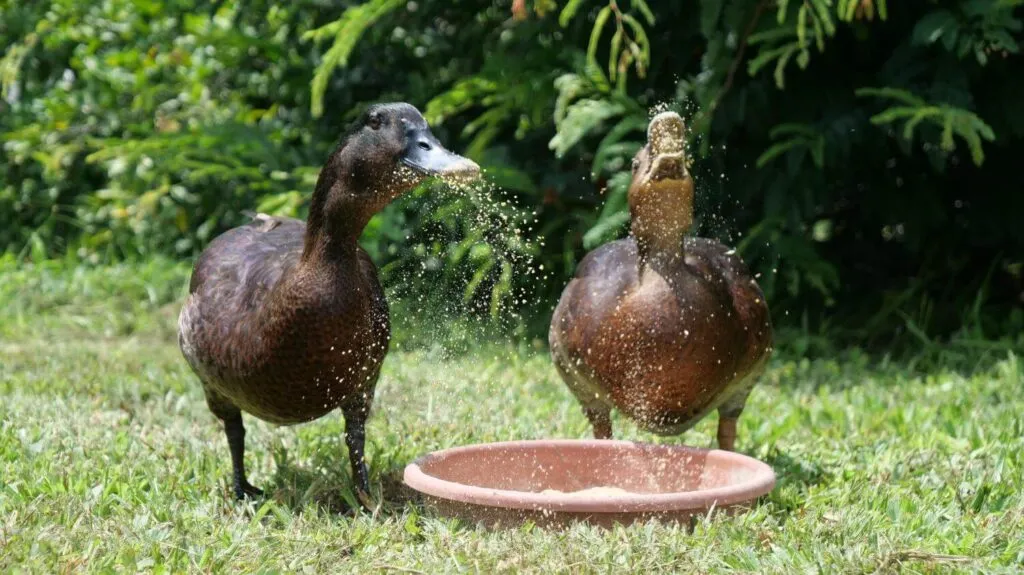
Not all the food you give your ducks goes into their mouths. They spill it, they sling it, they trample it into the ground, they put it in their water, and they in general distribute their feed throughout the surrounding area.
Furthermore, thieves such as wild birds and mice will capitalize on any feed they can find. I have heard of people who, after wondering why their ducks were consuming such tremendous volumes of feed, discovered that wild birds were actually taking the lion’s share. If you have dogs in the same area as your ducks, they are likely to steal food as well. (All three of our dogs love poultry food. But it goes both ways, because the chickens also love the dogs’ kibble!)
Here are some ways to reduce feed wastage:
- Choose a good feeder. It should be difficult to tip over. Most chicken feeders are rather wasteful when used for ducks, because their narrow troughs don’t accommodate duck bills very well and thus cause the ducks to spill large amounts of food. Open pans and bowls tend to be the least messy for ducks, as they allow the ducks to easily reach in and take a full mouthful, and much of the food they spill will fall right back into the bowl. Also, bowls work with wet or fermented feed, while most chicken feeders don’t. I like to use dog bowls and rubber feed pans.
- Don’t place the feeder over heavy grass or bedding. Most of the feed that is spilled will be forever lost, as ducks won’t scratch to find it as much as chickens will. If the feeder is over bare dirt, a concrete slab, or other relatively smooth surface, the ducks will be able to find and pick up some of the food they spill.
- Don’t feed mash. Ducks struggle with the fine texture of mash and will often resort to trying to swallow it with a mouthful of water. This results in much of their food being mixed with their water and wasted. When I gave my ducks dry mash, I would often dump their water bucket and find a layer of feed an inch thick on the bottom. Also, spilled mash is very difficult for ducks to clean up. They can’t pick small particles off the ground as well as chickens can.
- Wet the feed, especially if you’re feeding mash. If you’re not fermenting it, at least mix it with some water before you give it to your ducks. When it’s wet, they won’t feel the need to put it in their water before eating it, and they won’t spill and sling it around as much.
- Don’t feed free-choice, as covered above.
- If you are for some reason feeding free-choice anyway, try to secure the area where the feed is so wild birds and mice can’t access it. Treadle feeders, which open when a bird steps on a platform in front of the feeder, are supposed to prevent vermin and wild birds from stealing feed.
4. Change feeds
You may have considered switching to a cheaper brand or type of feed.
This could help reduce your feed costs, but not necessarily. Cheap feed may be lower in essential amino acids or have other shortcomings. As a result, your ducks may eat more of it to get the nutrition they need.
Many people find that when they switch their birds to a more expensive feed, their birds actually eat less feed and may even lay more eggs.
I recommend experimenting with the feeds available in your area. You may find that a more expensive feed will actually pay off in the long run, or you may find a cheaper feed that your birds do just as well on.
In addition, instead of buying pre-mixed feed, it’s possible to buy each ingredient separately and mix and grind them at home or on-farm. This is more labor-intensive, but is sometimes slightly cheaper, depending on availability and prices of the ingredients where you live.
There are various recipes for home-mixed feed online, but beware. Not all recipes truly make a balanced diet, and most online advice for making your own feed make it sound much easier than it is. Do your research and do some calculations to make sure your ducks are getting a balanced diet.
In general, a duck ration will include some mix of grains, some source of animal protein (commercially, they tend to use processed by-products; backyard poultry raisers usually use fish meal), and a vitamin/mineral mix.
5. Choice feeding
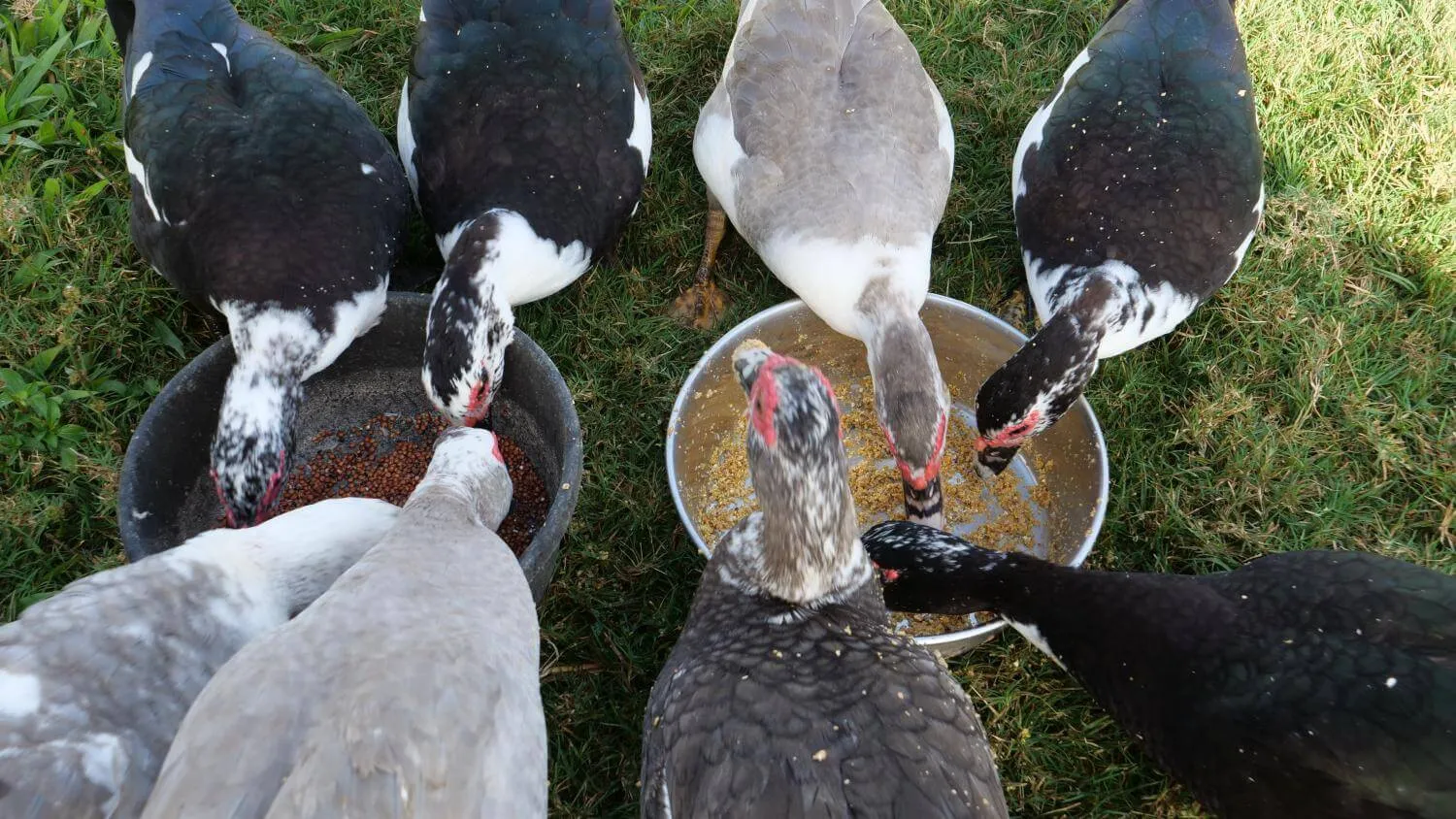
Choice feeding involves offering birds choices in what they eat, rather than feeding them one complete mix. Multiple studies have found that chickens are able to self-balance their own diet when allowed to select between various feedstuffs, which increases feed efficiency and does not decrease egg production.
Typically, choice feeding involves offering the birds, in separate feeders, a protein concentrate, a whole grain, and, if they are laying, a calcium supplement.
One study found that hens consumed 11% less food when they were allowed to choose between whole grains and a concentrate mixture than when they were fed a complete diet. Other studies had similar findings. Some did not find significant reduction in feed consumption, but did note improved eggshell quality or other improvements.
I have not seriously experimented with this, but I do feed my Muscovies both layer feed and milo (a type of sorghum, nutritionally similar to corn), and I have noticed that individuals that are actively laying prefer layer feed, while non-laying individuals prefer milo.
Here’s a review of studies which experimented with choice feeding: Choice feeding of poultry: a review
If you read the entire article, you’ll find one study done on ducks: a 2001 experiment in Vietnam which gave meat ducklings a choice between a high-protein and a low-protein mix. The fast-growing ducklings (unsurprisingly, in my opinion) preferred the high-protein food. While this study was unsuccessful at reducing costs, it was designed differently than most of the others, omitting whole grains. More research is still needed, certainly, but there are enough successful studies on chickens that I think this is still worth experimenting with and could be a good way to save money on feed.
Raw grain is typically cheaper than premixed feed, so any addition of raw grain that does not compromise your ducks’ health and dietary balance is likely to be worthwhile.
6. Sprout grains
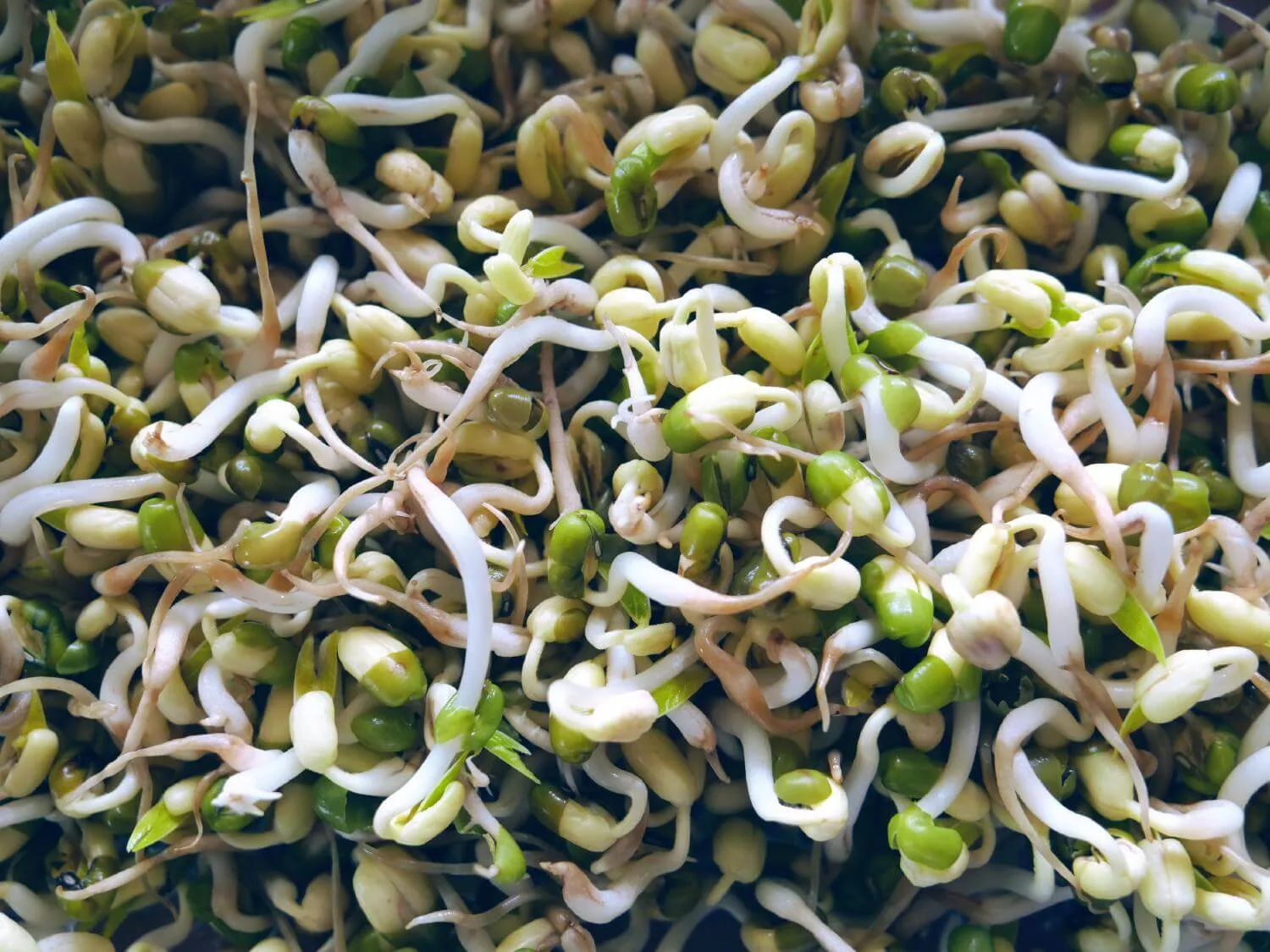
Mung bean sprouts—a healthy, nutritious snack for ducks.
Sprouting grains makes their nutrients much more bioavailable and more easily digested. It results in a tremendous reduction in antinutrients (reductions of up to 85%); a major increase of vitamin A, vitamin C, and vitamin E; increased availability of zinc, iron, magnesium, calcium, phosphorus, manganese, and B vitamins; increased protein; an increase in enzymes; and overall increased digestibility (by as much as 20-50%).
If you feed your ducks any whole grains (barley, wheat, oats, etc.), consider sprouting them first. Many other seeds (such as sunflowers, alfalfa, clover, broccoli, buckwheat, radishes, beans, and peas) can also be sprouted and fed to your ducks.
Sprouting grains involves soaking them for 8-24 hours, then draining them, then rinsing and draining them every day (or twice a day) until they sprout. You can either feed them to your birds immediately after they sprout, or you can continue to allow the sprouts to grow until there is some green fodder for your birds as well.
In winter, while your birds don’t have much access to forage, giving them sprouted grains will allow them to still enjoy live, green feed.
Here are some resources on how to sprout grains and seeds for your flock:
Sprouting Grains for Chickens: Fodder for Thought
Best and easiest way to sprout grains for chickens, BAR NONE!
7. Free range
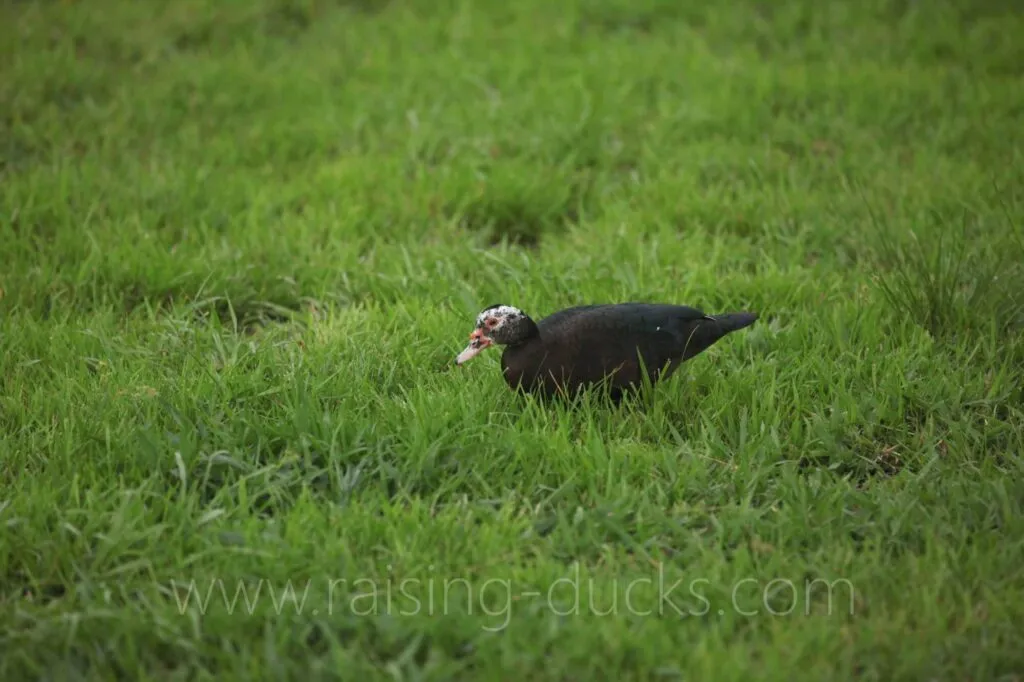
Allowing your ducks to forage freely is one of the best things you can do to reduce feed costs. Most ducks can find 20-50% of their own food if they have good foraging grounds. In some conditions, they may even be able to find all of their own food, albeit at the cost of lower egg production.
Unfortunately, free ranging isn’t an option for everyone, as it leaves your ducks vulnerable to predators. Depending on the predators in your area, it may not be worth the risk. Your ducks may also wander onto neighbors’ properties, so if you have a small yard and are in an urban area, free ranging may not be a good idea. Read more about the pros, cons, ins, and outs of free ranging here. Also, here’s a list of eight ways to make free-ranging safer.
8. Rotate pasture
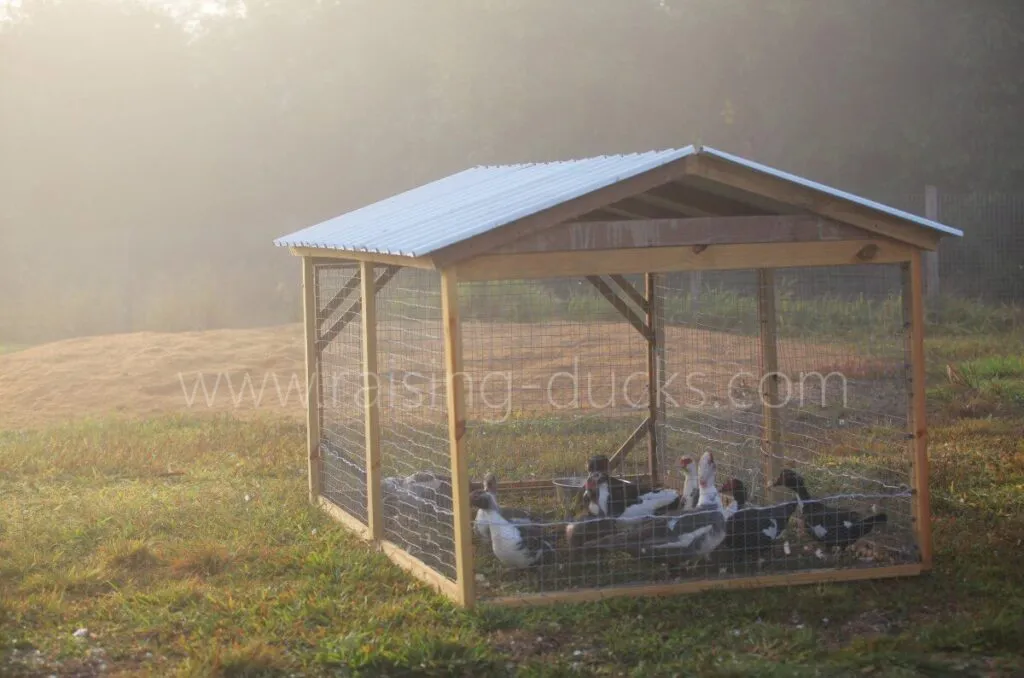
One of our mobile duck pens. Although we only use it to house ducks for the night, something similar could also be used as a full-time shelter for four ducks or less.
If you can’t free-range, consider mobile shelters or rotating your ducks through multiple runs. Even if you can free-range, rotational grazing has a number of benefits over leaving ducks in one area, such as reducing parasites and allowing the grass to recover from the damage the ducks inflict upon it. No matter how large an area your ducks free-range in, there will be favorite “hot spots” that they will destroy.
And of course, if your ducks are regularly moved to fresh pasture, they will be able to find much more food.
For small areas and small flocks, mobile pens can be a good option. Most designs can be moved by hand by one person, enabling you to move your ducks to a new patch of grass as often as necessary. Larger pens may need to be moved with a tractor or four-wheeler.
Another option is building two or more permanent runs. The more runs you can have, the better, but even two is better than one. Each run should be rested for at least four weeks after being used. (The same applies to mobile pens—try not to return the pen to an area it has already been for at least a month.) Hence, if you have two runs, your ducks would spend a month in one, then a month in the other, and so on. With four runs, your ducks would spend ten days in each before being moved on to the next.
Fencing multiple permanent paddocks can be expensive, so many poultry raisers opt for movable fencing, usually Electronet. Electronet is not only extremely easy to move but also will keep out nearly any land predator. With movable electric fences, you can create as many paddock areas of any size you want.
9. Hang light at night
If you hang a small light in your ducks’ nighttime enclosure just above the height of their heads, they will be able to eat the insects that are attracted to the light. Ducks, unlike chickens, are active during the night.
I saw this tip in Dave Holderread’s book, Storey’s Guide to Raising Ducks. I haven’t tried it yet and don’t know of anyone who has, but it’s worth experimenting with. Insects are one of the most valuable sources of food for ducks.
10. Feed leftovers/kitchen waste
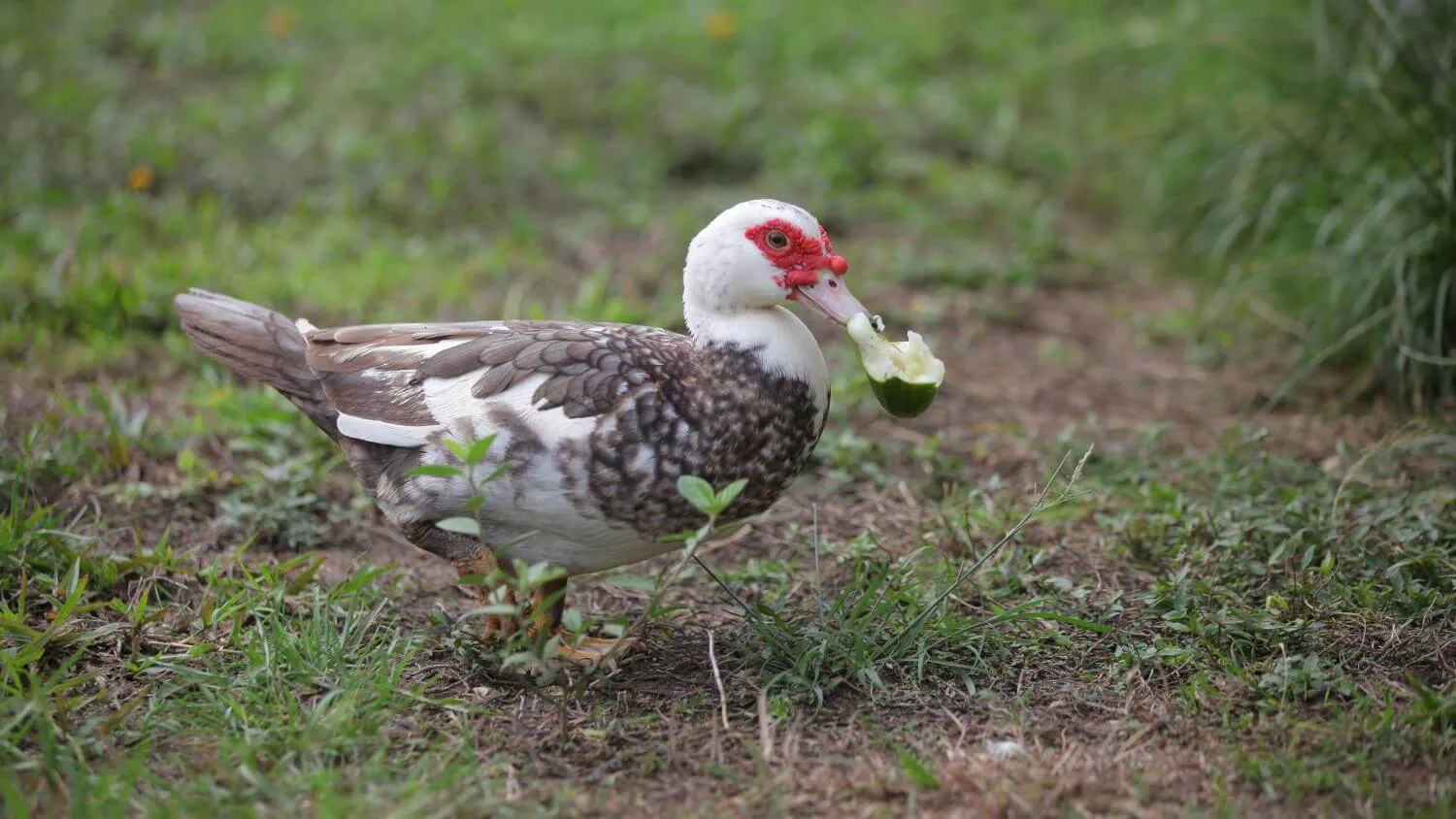
One of our Muscovy ducks eating a cucumber.
Some leftovers and kitchen waste are fine for ducks to eat and can be a great supplement for their diet. Wilted lettuce, cucumber peels (and overripe cucumbers), banana peels, and most other fruit and vegetable scraps are great for ducks. You can also feed ducks (in moderation) bread, rice, pasta, corn, peas, sweet potato, oats, and more.
Anything unhealthy for you is likely also unhealthy for ducks, so avoid giving your ducks anything sugary, processed, or fried. Don’t give your ducks any “dessert” foods.
Meat is great for ducks (even duck and chicken meat). Processed meats like pepperoni, bacon, and ham probably won’t kill your ducks, but they’re definitely unhealthy, so try to avoid them.
Excess eggs can also be fed back to your ducks, but boil them first. If you have dairy animals, excess milk or whey can also be given to ducks in moderate quantities.
Before giving your ducks table scraps, research what’s good for them, what’s okay in small quantities, and what should be completely avoided. Here’s a list (with 352 foods!) of what ducks can eat:
What Ducks Can and Can’t Eat: The Ultimate List
Also, farmer’s markets may have a supply of overripe, wilted, or otherwise sub-par produce that your ducks will still be able to eat. Often they will be glad to part with it, although if you live in a rural area, you may find that you’ll have competition from other like-minded poultry raisers, pig farmers, or people who compost. Be sure to inspect what you get to be sure it’s safe for ducks to eat.
11. Keep light breeds
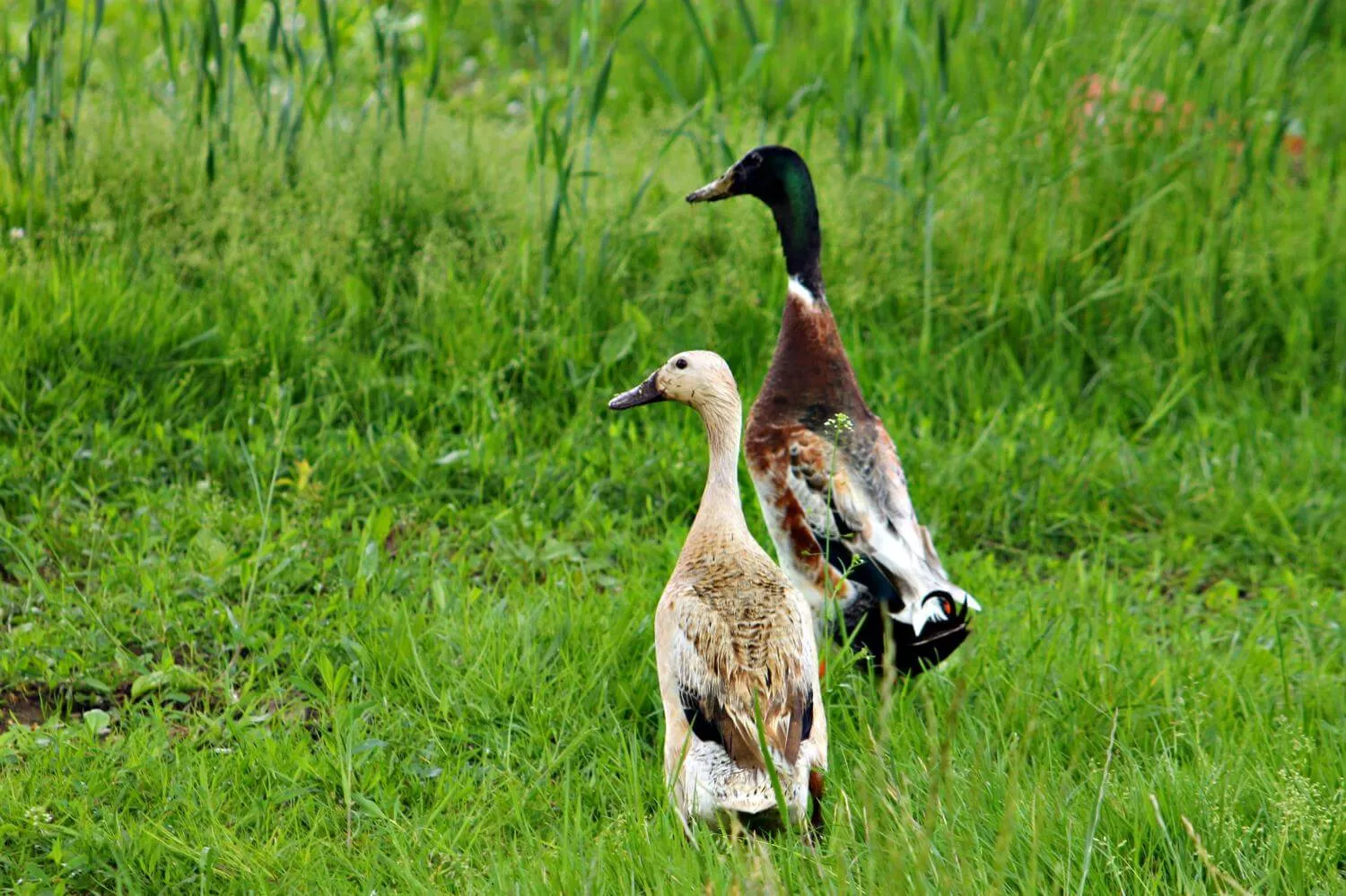
If you want ducks for eggs, don’t choose Pekins. Some Pekins lay a lot, but they also eat a lot. Light breeds like Indian Runners and Khaki Campbells may be a better choice. I’m not sure which ducks have the best feed conversion rate (FCR), but any breed used in commercial egg farms likely has a good FCR, or at least those individuals bred for production would.
Meanwhile, if you want ducks for meat, a quality Pekin will have a better feed conversion rate than any other duck.
12. Let your ducks into the garden
Many people buy ducks to use as a form of pest control in their gardens. This can be a win-win situation: your plants are freed of their pests, and your ducks get a juicy snack.
There is one big drawback: ducks like to eat most garden plants, too. The solution to this is to only allow them into the garden for limited periods. When they first enter, they will be more interested in the bugs than in your plants. Once they lose interest in bug-hunting, they will start to go for the plants, and that’s when it’s time for you to herd them out.
Orchards can be an even better place to put your ducks. The ducks won’t hurt the trees, but will instead fertilize them, eat weeds and pests, and eat much of the windfall fruit. We have several citrus and soursop trees that we joke are duck-powered: the ducks sit under them, fertilizing them with their poop, which makes them grow more, which makes them shadier, which makes the ducks sit under them more, which fertilizes them more. (Duck poop, unlike chicken poop, will not burn plants and does not need to be composted.) This year, our lime trees were so productive their branches bowed to the ground when they produced fruit.
13. Grow a ducky garden
Storey’s Guide to Raising Ducks says that in a 50’ by 50’ area, you can grow “a good portion” of the feed needed for six ducks. Hence, one acre might be able to produce the majority of feed needed for one hundred ducks.
There are dozens of nutritious plants, vegetables, and fruits you can grow to feed your ducks. Many of them can be harvested by the ducks themselves, so all you need to do is turn them loose in their garden to eat.
Here’s a list of ideas for plants you can grow:
- Corn
- Wheat
- Rye
- Sorghum
- Cowpeas
- Millet
- Mulberry (both leaves and fruit)
- Siberian pea shrub
- Pigeon pea
- Comfrey
- Amaranth
- Squash
- Pumpkin
- Melon
- Zucchini
- Kale
- Cabbage
- Broccoli
- Lettuce
- Cucumber
- Tomato
- Alfalfa
- Clover
- Fennel
- Sunflower
- Peas
- Beet
- Radish
- Chicory
- Sweet potato
- Buckwheat
- Berries (raspberry, blueberry, goumi berry, wolfberry, strawberry, etc.)
- Grapes
If you have a pond, there are even more opportunities.
- Wild celery
- Wild rice
- Wild millet
- Small bulrush
- Smartweed
- Chufa tubers
- Duckweed
14. Seed yard/pasture with nutritious grasses and weeds
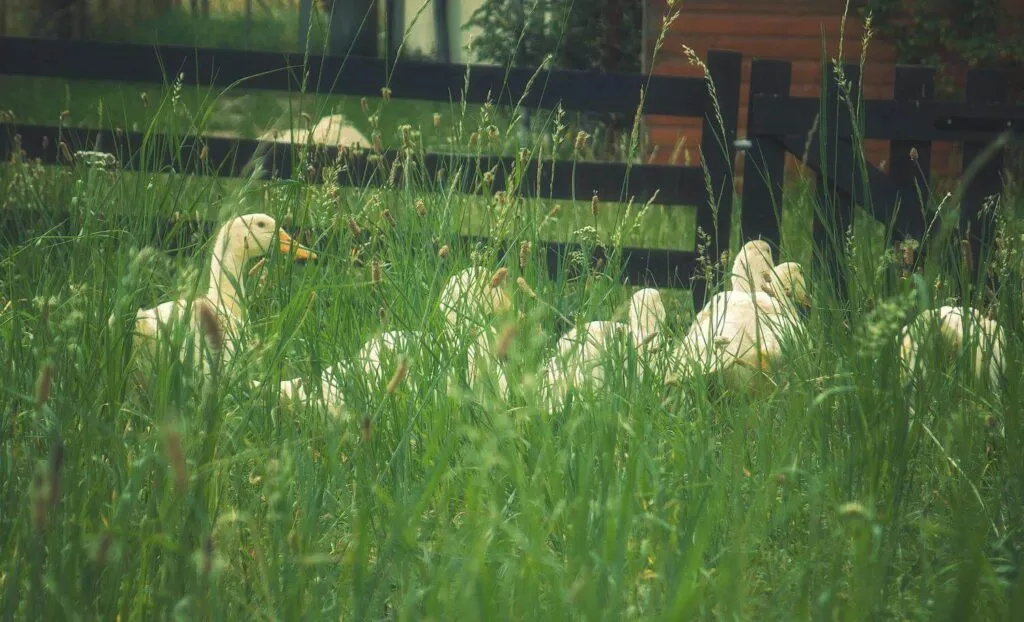
Lawn grass may look pretty, but it’s likely not very nutritious for your ducks. If you want to improve the value and quality of your ducks’ yard or pasture, plant grasses and weeds they can actually benefit from. Many grass and legumes used in pastures for larger livestock are also edible for ducks, and many “weeds” are actually very nutritious. Some examples include chickweed, dandelion, lamb’s quarter, stinging nettle, purslane, prickly lettuce, burdock, and yellow dock.
Mowing the grass from time to time will ensure fresh growth. Ducks won’t eat old, mature stalks of grass.
15. Grow soldier fly grubs, mealworms, or earthworms
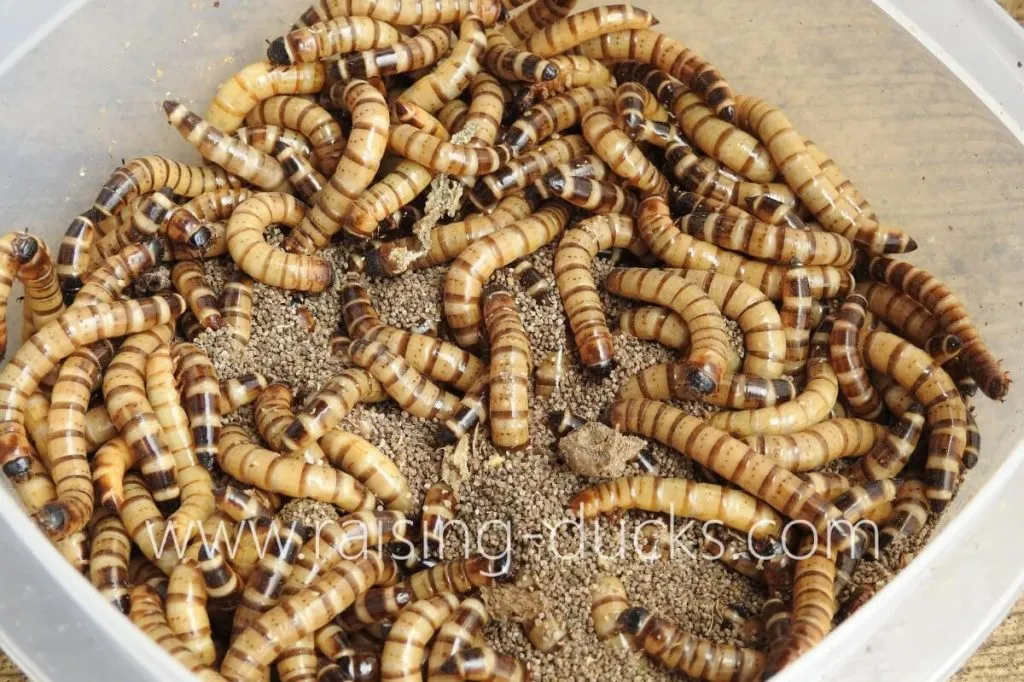
If you’ve had ducks for any length of time at all, you know how much they love insects, bugs, worms, and even larger creatures like lizards and small mice. Ducks need animal proteins in their diet; grains alone cannot suffice. Hence, worms—earthworms, mealworms, and/or superworms—are one of the best things you can raise at home to add to your ducks’ diet. Fly larvae and soldier fly grubs can also be easily cultivated.
Raising your own worms and larvae to feed your ducks is cheap and easy to do on a small scale. For a small flock, they can provide a valuable and substantial supplement.
Mealworms and superworms are usually raised in plastic bins and fed kitchen scraps and other compost. Soldier fly grubs need a slightly more complicated setup, which you can either make at home or purchase in the form of the BioPod. Raising earthworms requires a good source of manure.
What if I unbalance their diet?
Many of these tips involve feeding your ducks from outside sources other than their premixed diet. Often, people will tell you not to feed treats as more than 5% of the diet. They say that if you feed more, you will unbalance their diet, possibly causing health problems. It’s true that this is a risk.
However, if you feed your ducks a great enough variety of nutritious foods, attempting to mimic their wild, natural diet, it’s likely that the diet will be balanced enough. Ducks can balance their own diets when they find food by foraging, and if you’re careful to provide a variety in what you offer them, I highly doubt that you will run into any problems. Don’t be afraid to experiment.
Just remember: variety. If your duck diet supplementation consists entirely of lettuce, you will cause problems. Some years ago, I made the mistake of, without doing any research, feeding my ducks raw grains exclusively (I can’t remember if I used wheat or oats), which quickly caused a protein deficiency in my flock (and likely other deficiencies as well).
One last tip
If you’re serious about reducing feed costs and growing food for your ducks, Harvey Ussery’s book The Small-Scale Poultry Flock is a must-have. It has a chapter on making your own feed, a chapter on feeding the flock from home resources, a chapter on cultivating worms and larvae for your flock, and more. Pretty much the entire book is, directly or indirectly, about how to create a more self-sustainable flock with limited reliance on purchased feed.
Leave a comment
Your email address will not be published.